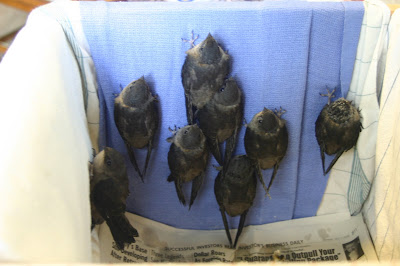 During our 2007 summer trip to Kanha, we saw these four vultures on the sal trees, as they sat and waited patiently for the tiger to leave its kill in the dry grassland below.
During our 2007 summer trip to Kanha, we saw these four vultures on the sal trees, as they sat and waited patiently for the tiger to leave its kill in the dry grassland below.Through our binoculars, we could see the vultures very clearly, but our cameras were not powerful enough to get a better shot. (Those little black specks in the photo on the left!)
We had heard how vultures have become a rare sight in India, and so we were all the more excited by our sighting. There they sat looking like the Jungle Book crew, and I would not have been surprised if they had broken into a "So what are we going to do now?" conversation!
Our jeep was filled with greenhorns, and when we returned to the dorm to share our sighting, there was much disbelief, as other senior members were quite sure we had seen some storks and mistaken them for the vulture! Our picture was not conclusive, but the profile - not a stork surely. Our "honour" was restored when the Kanha guide who came with us confirmed to them that yes, they were vultures!

 Lining a bund enroute to Nelappatu
Lining a bund enroute to Nelappatu




 The Pulicat dance troupe!
The Pulicat dance troupe!




 The undisturbed huge anthills
The undisturbed huge anthills Iora I think
Iora I think Rat snake!
Rat snake!
 Angel
Angel Sunshine
Sunshine


